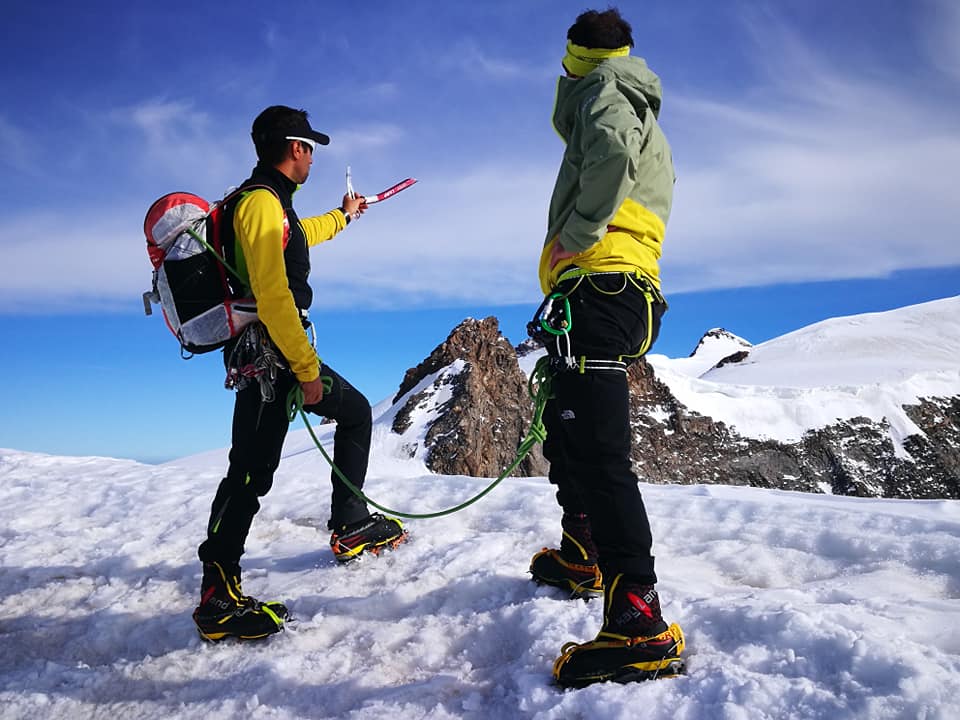Kayland and Luca Montanari: Emotional intelligence and mountaineering
Luca Montanari, Kayland ambassador, is a mountain guide, consultant for high altitude expeditions and mountaineer with a truly complete profile. Luca has been asked to talk about his lockdown approach and give some advice.
“Decades of studies have shown that the best leaders and teams are those with high emotional and social skills, including self-mastery, resilience under stress, empathy, influence and teamwork.
“I would add that these are the skills that distinguish the best performers of the 21st century”.
Rereading these statements, I would like to address the following question directly to Daniel Goleman (the father of emotional intelligence): Mr. Goleman, have you ever dealt with a mountain guide?
Among the countless skills that a Mountain Guide should have, I believe that emotional intelligence is one of the most significant and difficult to acquire.
Developing emotional intelligence means creating the conditions to build strong and solid relationships. In my case, it means establishing an exclusive connection with the client.
Creating a channel of communication (verbal and non-verbal) is very important, because the client does not just want to live a good experience, but dreams of entering a world of increasingly daring projects and new vertical discoveries that he is often unaware of or does not feel up to. The mountain holds our dreams and everyone wants to make at least one of them come true. Therefore, establishing an empathic relationship with the person who asks me to “go to the mountain” is an obligatory step.
Every time a connection is established, it is my “I” of the beginnings that speaks: the impressions of my first climbs, the adrenaline of the first vertical projects, the ecstasy of the first high altitude climbs, the dream come true of the first expeditions to the Himalayas. All these first times, which are unique and unrepeatable emotions, however, find a new reason to be in the emotions of customers who make their first long route, who climb their first four thousand or who approach an ice waterfall for the first time.
They are not only experiences to remember, but they are moments of life to awaken, to cultivate, to cure, to transform them into new goals to be achieved.
I remember a client who used to go to the Alps and the Dolomites with mountain guides, but who had long had the dream of going beyond the White, towards the majestic peaks of the Himalayas. We met, we found an understanding and a first goal to reach: a seven thousand, in a little known area of the Nepalese Himalayas. That mountain was not only a great goal, but a window wide open on a mysterious and extraordinary world made of Sherpa culture, millenary traditions, mountain life linked to a strong spirituality. From that seven thousand other expeditions followed, characterized by high peaks in unexplored contexts, until the opening of a new route on Gyanjikhang.
Another memory concerns a steep skiing course. Before the descent along a famous channel in the Dolomites, I caught a certain fear in a couple of guys in the group. I knew they would be able to ski without any problems: they just had to manage their mood at that moment and take confidence. I kept them close to me, before each turn I looked for their gaze, with a few decisive signals I showed them to breathe and gave them the signal at the exact moment when they made the jumped turn. I remember their smile at the end of the channel: they couldn’t believe what they had just done! Seizing their state of mind, not making them feel uncomfortable, instilling the necessary courage to take confidence and overcome their limits together were the real conquests of that exit, on a day where empathy made the difference.
As a guide, I live double emotions in the mountains: mine and those of the people I accompany. Our communication (verbal, non-verbal and paraverbal) becomes an integral part of our technical equipment; it is as indispensable as my rope, because it conveys confidence and safety to the person who is with me at that moment. During a steep ski descent, along a sharp ridge, on an exposed rock passage, the tone of my voice, the expression on my face and stretching the rope at the right moment to give courage to the client are gestures that are part of my experience on the wall.
In my job there is no routine: repeated ascents are always different, the people I rope with change, the conditions of the walls change, the moods change, the weather changes. And the emotions change, each time shared with different people.
I like to think that the job of driving is not simply “accompanying people in the mountains”, but rather “helping people to find their way in the mountains”. It is often a long journey, made up of lessons, gradual progress, setbacks and new goals to achieve, but always governed by a deep and exclusive empathic connection, which puts our team in a position to reach its summit, whatever it may be.

